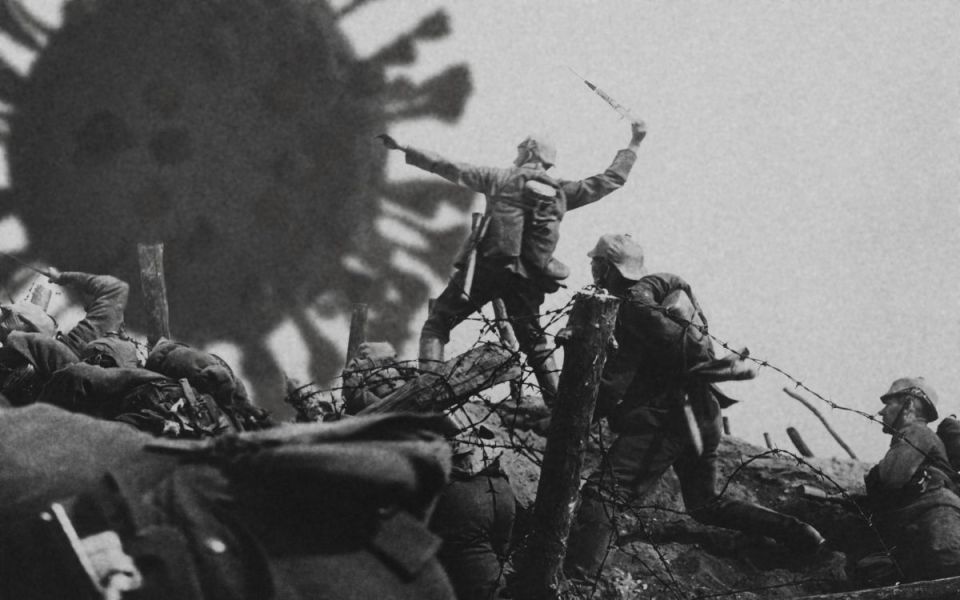What Happened After World War One? World War Flu

Spring, 1918. Germany begins its spring offensive in the final year of the First World War, a conflict that would kill 15-22 million people. Although this conflict dominated headlines in the US and in Allied countries, Madrid’s ABC newspaper in neutral Spain reported an even deadlier crisis: the flu.[1]
Today, Americans mostly think of the flu as an annoying, mild illness that takes you and the kids out of work and school for a few days. In reality, the flu is still among the deadliest and most widespread epidemics, killing 28,000 - 100,000+ children under five every year around the world.[2,3] Before the introduction of widespread flu vaccines, the flu was a major cause of death and disease.
The first historic pandemic attributed to the flu is sometimes claimed to have occurred in Greece around 2,400 years ago.[2,3] Several hundred years ago, an outbreak in Italy earned the disease the name influenza, the Italian word for “influence.”[2,3] Influenza became the name of the flu in English. This disease set in among the people and became an epidemic, from the Greek roots epi- (“upon”) and -demos (“the people”). Periodic heavy outbreaks spread every 10-40 years among all people in pandemics, from the Latin pan- (“all”) and -demos (“the people”).[2] In 1889, a well-documented epidemic of flu spread more rapidly than ever before, spreading along new transportation systems like steamships and railroads and causing around a million deaths - a huge number at the time.[3]
This pales in comparison to the flu that was reported in Madrid in May 1918. The disease originated outside of Spain, but other countries were heavily suppressing reports to keep morale high during the war.[1,3,4] Spain, being neutral, had no similar restrictions and freely reported on the disease, which was infecting everyone from peasants to cabinet members and even King Alfonso XIII.[1] Influenza deaths were somewhat milder in Spain compared with other countries, but they were reporting the highest numbers (since everyone else was censoring information), and the outbreak became known as the Spanish Flu.[3] The medical response was poor, owing to a general misunderstanding of what causes the disease (they thought it was a bacteria, not a virus) and a lack of doctors, many of whom were busy treating the war wounded.[3] All told, the “Spanish Flu” of 1918 infected around half the global population and killed an estimated 40-50 million people, 2-3 times as many as died in World War I.[2,3] Since 1918, there have been a few other notable pandemics of flu, including the 1957 Asian Flu, 1968 Hong Kong Flu, 1977 Russian Flu, and 2009 Swine Flu.[2,3] In addition to pandemics, most countries experience seasonal flu epidemics almost every year.[5] This is in spite of great advances in understanding, medicine, and vaccines, so what gives? What is it about the flu that makes it so hard to defeat, and what’s being done about it?
The flu is caused by a variant of the influenza virus. There are 4 major families of influenza virus, labeled A, B, C, and D.[3,6] Types A and B cause seasonal epidemics, and type A has the highest potential for becoming a full-fledged pandemic.[3,6] Genetically, the virus has single-stranded RNA, which can’t be corrected for errors as it replicates, making it highly vulnerable to genetic drift, where small changes accumulate to make distinct strains.[3] This code is made of 8 genes, which code for 11 proteins.[3,6,7] Two of these proteins, hemagglutinin [hee-ma-glute-nin] (H) and neuraminidase [neura-mina-dace] (N), sit on the surface of an influenza virus and enable the virus to enter our cells to reproduce and exit cells to infect others.[3] Since these proteins are on the outside of the virus particle, they are the parts most critical for immune response and vaccine targets. Unfortunately, the high variability of H and N proteins means immunity from infection or vaccine doesn’t last very long; hence, the yearly flu season.[3,6] Even worse, if multiple strains of influenza infect an animal or person at the same time the viruses may combine into a new, virulent, very hard-to-stop version in a rare process called genetic shift.[3,6]
To summarize, the flu is dangerous, contagious, has been plaguing us for hundreds or thousands of years, and constantly mutates in ways that make lasting immunity difficult, so how can we fight it? We fight it with constant monitoring of new strains, public vaccination efforts, clinical trials searching for more effective vaccinations, and several generations of medical and scientific advancement.[5,6,7] The World Health Organization (WHO) uses over 100 research labs around the world to look for the most likely new epidemic strains; those with H and N mutations that would make them contagious and able to evade current immunity.[5] Once the most likely new strain is determined, the public vaccination machine starts in earnest. Over the years, producing vaccines was done by using a virus strain that was associated with a mild illness, a version that was killed and unable to reproduce, or a virus that was altered to stimulate an immune response without causing illness.[6,7] New methods are now looking at ways to produce vaccines that don’t contain any of the dangerous virus particles and instead contain the RNA code that builds H and/or N proteins. This gives our body a fighting chance to produce antibodies for the most likely strain of influenza virus and help win the war against the flu.
Creative Director Benton Lowey-Ball, BS, BFA
|
Click Below for ENCORE Research Group's Enrolling Studies |
|
Click Below for Flourish Research's Enrolling Studies |
References:
[1] Trilla, A., Trilla, G., & Daer, C. (2008). The 1918 “spanish flu” in spain. Clinical infectious diseases, 47(5), 668-673. https://doi.org/10.1086/590567
[2] Lina, B. (2008). History of influenza pandemics. In Paleomicrobiology: past human infections (pp. 199-211). Berlin, Heidelberg: Springer Berlin Heidelberg.
[3] Saunders-Hastings, P. R., & Krewski, D. (2016). Reviewing the history of pandemic influenza: understanding patterns of emergence and transmission. Pathogens, 5(4), 66. https://www.mdpi.com/2076-0817/5/4/66
[4] Barry, J. M. (2004). The site of origin of the 1918 influenza pandemic and its public health implications. Journal of Translational medicine, 2(1), 3. https://pmc.ncbi.nlm.nih.gov/articles/PMC340389/
[5] Potter, C. W. (2001). A history of influenza. Journal of applied microbiology, 91(4), 572-579. https://doi.org/10.1046/j.1365-2672.2001.01492.x
[6] Francis, M. E., King, M. L., & Kelvin, A. A. (2019). Back to the future for influenza preimmunity—Looking back at influenza virus history to infer the outcome of future infections. Viruses, 11(2), 122. https://www.mdpi.com/1999-4915/11/2/122
[7] Hannoun, C. (2013). The evolving history of influenza viruses and influenza vaccines. Expert review of vaccines, 12(9), 1085-1094. https://doi.org/10.1586/14760584.2013.824709



